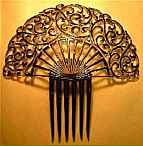
Hair Combs and Ornaments
Sarah Perkins detangles the topic of hair combs and ornaments.
Popular designs in jewellery often reflect the fashions of the day. Necklace design is limited by the current trend in necklines, and bracelets tend to be out of favour when cuffs are heavily frilled.
 |
The popularity of hair ornaments was affected by two main factors: hairstyles & hats. The interaction of these two elements of fashion lead to the production of an amazing variety of hair ornaments.
Combs were made in every kind of material imaginable, from lead & iron to the new plastics, and there was something on the market to suit every pocket. Cheap materials like horn were dyed to resemble expensive tortoise shell. The invention of plastics in the second half of the 19th century lead to enormous scope for mass production.
There were endless possibilities for imitating expensive materials by fusing, moulding & dyeing celluloid, casein and other newly discovered plastics. New processes transformed rubber so that it could resemble ebony. Many of the combs that have survived were made from these new materials, embellished with improved glass, cut with recently discovered techniques to resemble diamonds or jet.
 |
The wealthier classes wore combs of gold & silver, decorated with precious stones. It was not uncommon for a parure (a set of matching jewellery) to included a high back comb, and a pair of side combs. Some parures were designed to be flexible. Elements like brooches and earrings could be joined together to form a bracelet, or fixed to a chain to make a necklace. Some of these had a metal comb with a wire frame to which the jewelled parts of the set could be pinned. Many of these sets have not survived, because they were often more delicate than similar less versatile items, and were used more often. Many of the better quality ornaments went out of fashion, and were broken up to be made into something more wearable.
The techniques of mass production have not left many clues to the origins of combs. A few bear patent marks, but in most cases, unless there is a hallmark nothing can be established for certain. Date can be estimated from the style of the design, but that can only ever be a rough guide. Across Europe and America, fashions were so similar that it is not possible to trace the place of manufacture from the style. Oriental hair ornaments are more recognisable, as they were made to fit more standard hairstyles.
Sarah Perkins is a collector of combs and hair ornaments.
The best books on this subject that are readily available are:
"Collectors Guide to Hair Combs: Identification & Values" by Mary Bachman (ISBN 1574320483), which has information about materials and manufacturing processes."Combs & Hair Accessories" (Antique Pocket Guides) by Norma Hague (ISBN 0911403116), which has quite a lot of information about fashions in hairstyles.
(Editor's Note: The September 2001, November 2001 & February 2002 Issues of Antique Collecting and the October 2001 Issue of The American Museum in Britain Annual Journal had articles relating to hair ornaments.)
To learn more about hair ornaments, visit Sarah's website: Comb Base